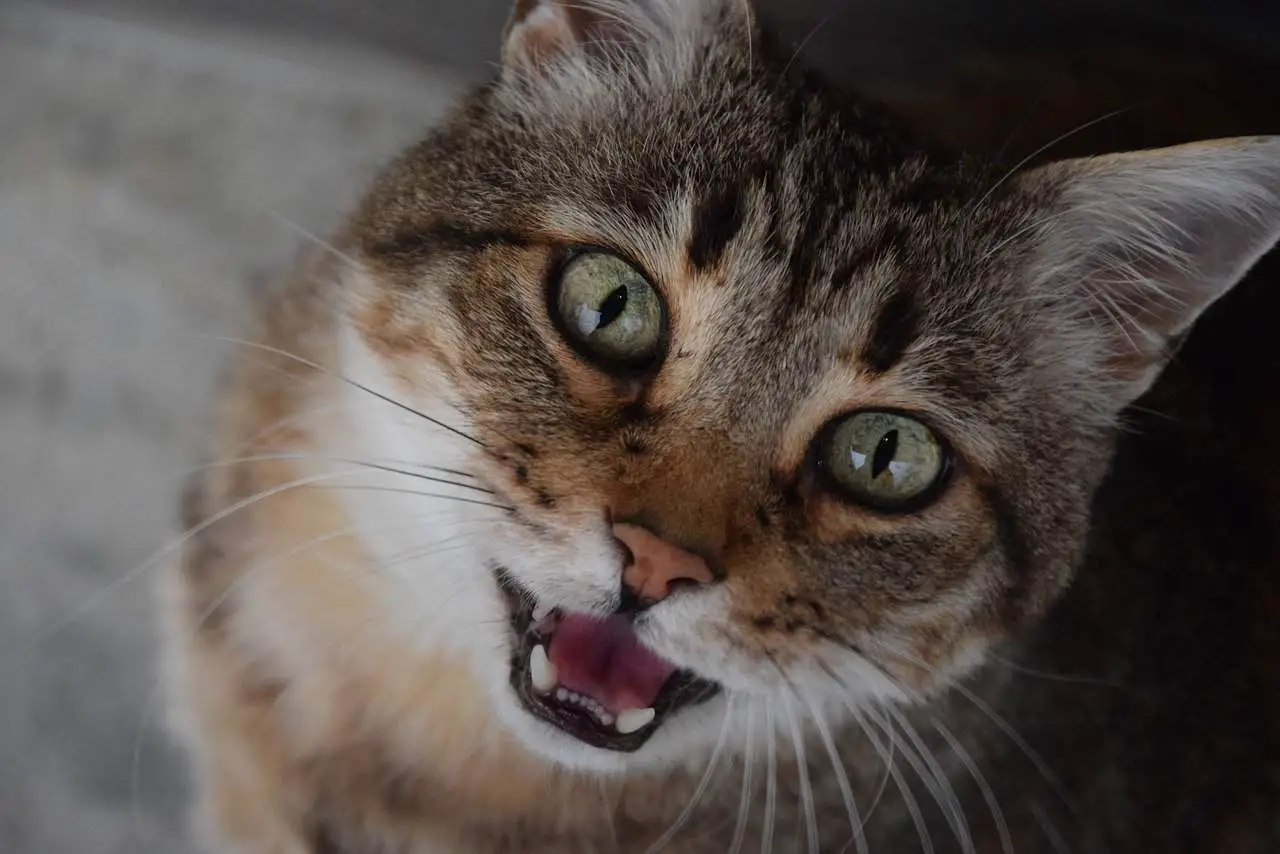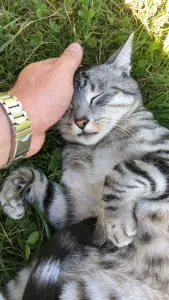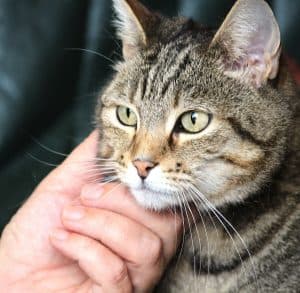We all know how soft cat fur feels under the fingertips and how impeccable their hygiene is. However, as a cat owner, I’ve become accustomed to the ailments that most felines have to battle at least once in their lives. More importantly, I know that some could be a sign of a severe underlying issue. So, when I noticed an excessive amount of loose fur around my home, the only question on my mind was — why is my cat’s hair coming out in clumps?
Some may think that hair loss in cats is rather common. We’ve all seen just how much hair stays on our clothes once the feline leaves our lap after a short cuddling session. Nevertheless, if the fur is coming out in clumps, that might be a sign to get the cat to the vet. It could be suffering from feline alopecia.
Why Is My Cat’s Hair Coming Out in Clumps? About Feline Alopecia
Due to stress or some other underlying factors, our hair can start falling out in chunks, leaving bald patches all over.
The same thing can happen to felines. Alopecia in cats is a somewhat common issue, and it comes in a few forms. It can be partial or complete, and the cat can lose hair symmetrically or in entirely random order.
The problem is — feline alopecia can be caused by practically anything and everything. Some of the triggers require extensive testing, especially since some cats can be born with it.
Why Is My Cat’s Hair Coming Out in Clumps? — 8 Possible Causes
- Parasites and Fleas
- Mites
- A fungal infection
- Allergies
- Psychogenic Alopecia
- Hormone imbalance
- Cancer
- Poor Nutrition
Owning a dog and a cat, or living in an area where the cat has easy access to the outside, could be the reason the feline is suddenly losing its fur. If it can go outdoors and mingle in nature or is in close contact with a dog every single day, it can get bitten by a flea.
Now, the cat may not shed hair because of fleas themselves. The cause of alopecia, in this case, is a flea bite allergy. If the feline is sensitive to the flea’s saliva, it can develop alopecia, especially in its hindquarters.
Unfortunately, it only takes one flea to trigger a rather unfortunate, and sometimes prolonged reaction. That’s why it’s a must to take the cat to the vet immediately to avoid any further skin and fur damage.
Luckily, the condition is easy to treat with some flea treatments and shampoo. If the itching is persistent, and the hair loss excessive, the vet may also prescribe antihistamines or corticosteroids.
Mites
However, fleas aren’t the only parasites cat owners should worry about. Although Demodex mites are common in most mammals, when their population rises through the roof, they can cause intense itching, skin lesions, and hair loss, among other things.
A mite infestation usually occurs when the cat’s immune system isn’t functioning properly. Because of that, it’s not uncommon in stressed cats or felines that are already sick from some other condition. Furthermore, if its hormone levels rise or the cat starts producing excess oil, an outbreak of Demodex mites is the usual consequence, with a condition called mange as the end result.
In most cases, the mite infestation is evident around the cat’s eyelids, flank, head, and neck. Apart from missing clumps of fur, its skin will also be scaly, with lesions and crusty patches.
To confirm the presence and determine the type of mite that’s causing the issue, the vet will rely on skin scraping. Sometimes, analyzing the hair can also help with the identification. There may be a need to do a urine test as well to rule out other conditions with similar symptoms.
The good news is that in 90% of cases, demodectic mange resolves itself over time. Still, if it’s severe, long-term medications and lime-sulfur dips could be necessary to manage the condition and help the cat heal.
Fungal Infection (Ringworm)
Although the condition has “worm” in it, it’s actually a fungal infection that can be easily transmitted to humans. Cats usually get it if they come into contact with other infected animals. From there, the infection spreads, and it can wreak havoc in your home, no matter if you have an older cat or a kitten.
Bald patches on the cat’s skin are the most common symptom. A ringworm infection causes the hair to become quite brittle, so it breaks off, leaving behind clumps. It most often affects the areas around the feet, ears, and face.
The skin will show signs of infection too; ears, feet, and parts of the face may seem a bit reddish, and there could also be some white or grey crust as well. Overall, the hairless skin will appear dry and flaky.
While searching for an answer to Why is my cat’s hair coming out in clumps? this infection seemed like the biggest red flag to me. Since my cat had been leaving clumps of hair behind and some hairless parts were rather dry to touch, I had to confirm the diagnosis with my vet.
Luckily, the cat got better in no time. To confirm the infection, the vet analyzed the fungal skin culture. Treating it included using a variety of antifungal topicals, such as shampoos, sprays, and creams. The treatment can also include oral medications, but in our case, they weren’t needed.
Allergies
If the cat is allergic to dust or pollen, something in its food, or certain medications, its body will start to itch, causing it to over-groom excessively to soothe itself. That can lead to hair coming out in clumps, as the cat will lick the fur until there’s a bald spot.
Common allergens include beef, dairy, and fish. To check whether the cat’s food is no longer suitable, you can try switching to other brands for a while. Additionally, environmental allergies, such as those to mold spores and grass, can also cause atopic dermatitis on:
- Underarms
- Wrists and ankles
- Groin
- Around the eyes and between toes
- Around its muzzle and ears
To confirm the allergy, the vet will examine the cat and its whole medical history. Sometimes, serologic allergy testing and intradermal testing may help with determining the cause.
Treatment, however, depends on the allergen and the level of sensitivity. If the cat is hypersensitive, hyposensitization therapy could help. On the other hand, to reduce the itching, the vet may prescribe anti-itching sprays, antihistamines, and corticosteroids, as well as Cyclosporine (for long-term allergies).
Psychogenic Alopecia
Another form of alopecia not many cat owners consider at first is the psychogenic one, which makes the cat pull out and chew its own hair due to anxiety, stress, or fear. However, since cats love their routines and aren’t that easy to adjust to new people and environments, this form of alopecia is relatively common.
The main problem here is the cat’s behavior because it’s using its grooming as a way to relax. When it’s under too much stress, that can evolve into over-grooming, causing the feline to lick away fur until the area is bald.
The best way to cope with this form of alopecia is to actually take better care of the cat. It’s imperative not to put it under too much (unnecessary) stress and to maintain a steady routine. In more severe cases, though, anti-anxiety medications are also an option.
Hormonal Imbalance
Now, while looking for an answer to Why is my cat’s hair coming out in clumps, don’t be surprised if you see hyperthyroidism on the list of common causes. When the cat is suffering from an overproduction of T4, it’s not uncommon for its fur to appear unkempt and greasy, with a few bald patches here and there.
That’s only one of the symptoms of an overactive thyroid. To diagnose the condition, the vet will have to not only test the hormone levels but also rule out kidney failure and diabetes. Both of these conditions share some of the symptoms.
On the other hand, the cat may be suffering from a hormonal imbalance not related to its thyroid. Its level of steroids could be high, causing the death of hair follicles, often in a symmetrical pattern. One of the most common causes of that is Cushing’s disease, which is a metabolic disorder that’s rather difficult to diagnose. It shares many of its symptoms with diabetes, but it can lead to hair loss and thin, fragile skin as well.
In both cases, medications and surgery are options. If it’s hyperthyroidism, the cat may also have radioactive iodine therapy.
Cancer
In some rare cases, cats who develop cancer may also suffer from alopecia. This is mostly caused by neoplasia, the presence of abnormal growths, which occur due to the uncontrolled division of cells. Additionally, the feline may develop paraneoplastic alopecia (its skin will be moist but itchy) due to a malignant pancreatic tumor, a metastasizing intestinal carcinoma, or a bile duct carcinoma.
Poor Nutrition
Finally, the problem may be poor nutrition. Today, commercial pet food is full of fillers that “bulk up” the end product but carry little to no nutritional value at all. Because of that, it’s not uncommon for the cat’s fur to suffer while it’s eating poor-quality food. It’s not getting enough nutrients to maintain it!
However, as bad as this sounds, the hair loss is reversible. You’d have to switch to a healthier brand of cat food. The fewer fillers there are, the better; they aren’t doing anything for the cat’s health anyway and could lower its quality of life. You could also consider getting some powdered vitamins that you can add to the food to boost its nutritional value.
But in some cases, the food may not be at fault either. If an underlying condition is preventing the cat from absorbing nutrients, the vet will have to deal with that first.
Why Is My Cat’s Hair Coming Out in Clumps? — Other Conditions to Keep in Mind
- Arthritis: In some cases, localized pain may be to blame if the cat is losing chunks of fur. It may decide to lick the parts that are in pain until they’re bald to get some relief.
- Medication Side Effects: Some conditions, such as allergies and irritable bowel syndrome, may require the use of steroids, specifically prednisone. Although it could help with inflammation and management of cancer (it acts as an immune system suppressant), one of its side effects is alopecia.
- Stud tail: In case of uninterrupted secretion of the supracaudal gland’s sebaceous glands, the cat (often an intact male) may have a waxy patch and blackheads at the base of its tail. This is a skin disease called a stud tail that can be treated with antibiotics or neutering. The use of antiseborrheic shampoos is advised as well.
Final Thoughts on Why Is My Cat’s Hair Coming Out in Clumps?
If you were asking yourself Why is my cat’s hair coming out in clumps? but are still unsure of the exact cause and possible treatment, it’s best to let the vet diagnose your cat. The conditions I’ve talked about are the most likely culprits, and in some cases, you may be able to manage the hair loss yourself. However, only the vet can consider all the symptoms and test blood, urine, and bacterial culture to determine the cause.
Therefore, don’t be alarmed by some of the more severe conditions on this list. More often than not, fleas are the reason your cat’s fur is losing its fluff. So, take it to the vet as soon as possible to begin treating it with some anti-flea shampoo. Neither the cat nor the fleas will love that part, but at least your pet will once again have a shiny, full coat!
[su_box title=”Affiliate Disclosure”]This website is supported by its readers. Please assume that all links are affiliate links. If you make a purchase from one of the links we will make a commission from Amazon. Thank you.[/su_box]








